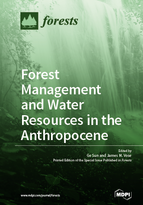Forest Management and Water Resources in the Anthropocene
A special issue of Forests (ISSN 1999-4907).
Deadline for manuscript submissions: closed (15 November 2015) | Viewed by 90903
Special Issue Editors
Interests: effects of climate change and land management on water quantity and quality, and water supply and demand at a regional scale; Application of computer simulation models, GIS, and remote sensing in regional hydrology; Evapotranspiration and ecosystem productivity modeling at regional to continental scales
Special Issues, Collections and Topics in MDPI journals
Interests: ecohydrology; climate change; watershed ecosystem structure and function; disturbance ecology; fire ecology; restoration ecology
Special Issue Information
Dear Colleagues,
Decades of research has provided a depth of understanding on the relationships among forests and water, and how these relationships change in response to climate variability, disturbance, and forest management. This understanding has facilitated a strong predictive capacity and the development of best management practices to protect water resources with active management. Despite this understanding, the rapid pace of changes in climate, disturbance regimes, invasive species, human population growth, and land use expected in the 21st century is likely to create substantial challenges for watershed management that may require new approaches, models, and best management practices. These challenges are likely to be complex and large scale, involving a combination of direct effects and indirect biophysical watershed responses, as well as socioeconomic impacts and feedbacks. In this Special Issue of Forests we explore the complex relationships between forests and water in a rapidly changing environment, examine the trade-offs and conflicts between water and other resources, and examine new management approaches for sustaining water resources in the future.
Dr. James M. Vose
Dr. Ge Sun
Guest Editors
Manuscript Submission Information
Manuscripts should be submitted online at www.mdpi.com by registering and logging in to this website. Once you are registered, click here to go to the submission form. Manuscripts can be submitted until the deadline. All submissions that pass pre-check are peer-reviewed. Accepted papers will be published continuously in the journal (as soon as accepted) and will be listed together on the special issue website. Research articles, review articles as well as short communications are invited. For planned papers, a title and short abstract (about 100 words) can be sent to the Editorial Office for announcement on this website.
Submitted manuscripts should not have been published previously, nor be under consideration for publication elsewhere (except conference proceedings papers). All manuscripts are thoroughly refereed through a single-blind peer-review process. A guide for authors and other relevant information for submission of manuscripts is available on the Instructions for Authors page. Forests is an international peer-reviewed open access monthly journal published by MDPI.
Please visit the Instructions for Authors page before submitting a manuscript. The Article Processing Charge (APC) for publication in this open access journal is 2600 CHF (Swiss Francs). Submitted papers should be well formatted and use good English. Authors may use MDPI's English editing service prior to publication or during author revisions.
Keywords
- streamflow
- drought
- floods
- climate change
- disturbance regimes, management
- water scarcity







